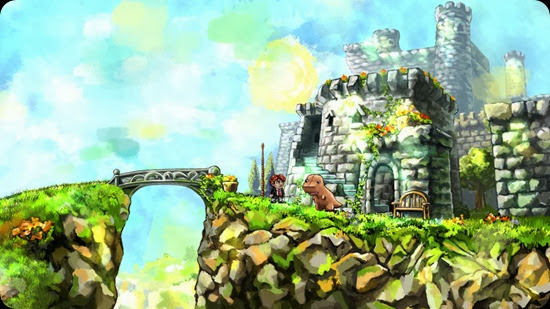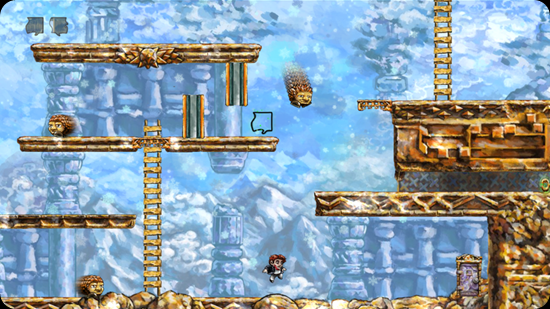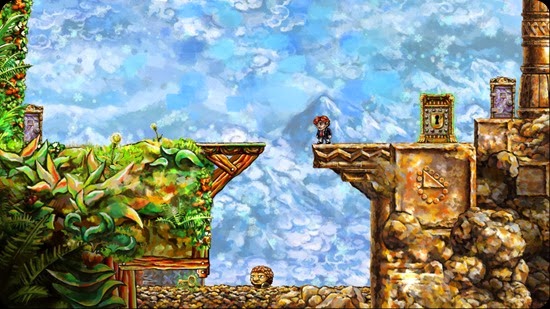Braid is a platform and puzzle video game developed by Number None, Inc. The game was released on August 6, 2008 for the Xbox 360's Xbox Live Arcade service. A Microsoft Windows version was released on April 10, 2009. Hothead Games ported and released the game to Mac OS X on May 20, 2009 and the PlayStation Network on November 12, 2009. A Linux port, created by Ryan C. Gordon, was released December 14, 2010 as part of the second Humble Indie Bundle.
The basic story elements unfold as the protagonist, Tim, attempts to rescue a princess from a monster. Text passages laid throughout the game reveal a multifaceted narrative, giving clues about Tim's contemplations and motivations. The game features traditional aspects of the platform genre while integrating various powers of time-manipulation. Using these abilities, the player progresses by finding and assembling jigsaw puzzle pieces.
Jonathan Blow designed the game as a personal critique of contemporary trends in game development. He funded the three-year project with his own money. Webcomic artist David Hellman drew the artwork, which underwent several iterations until it satisfied Blow's vision. A preliminary version of Braid without the final artwork won the "Innovation in Game Design" award at the 2006 Independent Games Festival; the final version received additional accolades. The game received highly positive reviews from critics, eventually becoming the highest critically rated title on Xbox Live. Some reviewers, however, criticized the game's price relative to its length.
Braid is played by solving physical puzzles in a standard platform game environment.
The player controls the protagonist Tim as he runs, jumps, and climbs across the game's levels. Tim jumps and stomps on enemies to defeat them, and can collect keys to unlock doors or operate levers to trigger platforms. A defining game element is the player's unlimited ability to reverse time and "rewind" actions, even after dying. The game is divided into six worlds, which are experienced sequentially and can be entered from different rooms of Tim's house; the player can return to any world previously visited to attempt to solve puzzles they missed.
Each world has its own time-based game mechanic:
2. Time and Forgiveness plays as an ordinary platform game, except that the player may rewind time to undo their actions. The section includes several challenges that would be unplayable or unfair in an ordinary platform game, but become feasible when the rewind mechanic is available.
3. Time and Mystery introduces objects surrounded by a green glow that are unaffected by time manipulation; for example, switches will remain flipped even if time is rewound to before the action occurred. Rewinding can thus be used to change the synchronization between objects that can and cannot be rewound, the basis of many puzzles in this section. This theme is also used in later worlds to denote objects unaffected by the player's time manipulation.
4. Time and Place links the passage of time to the player character's location on the horizontal axis. As the player moves toward the right, time flows forward, while moving toward the left reverses the flow; standing still or moving vertically will pause time. The player's location must be carefully managed in relation to enemies and objects.
5. Time and Decision involves a "shadow" of the player character appearing after the player rewinds time and performing the actions that the real player character rewound; if the timeline expires, the shadow will complete any initiated falls and jumps but will otherwise stand still before disappearing. Things coloured in violet can interact both with the main character and its shadow at the same time. Puzzles in this section revolve around using this mechanic to carry out multiple actions at once.
6. Hesitance provides the player with a magic ring which, when dropped, warps the flow of time around itself; the closer moving objects (including Tim) are to it, the slower time passes for them. The regular rewind control remains available.
The final world is labeled simply as "1." In this world, time flows in reverse. Rewinding time returns the flow of time to its normal state.
Each stage contains puzzle pieces that must be collected to create jigsaw puzzles that tell the story, and to unlock the last stage. On completing the main game, a speedrun mode becomes available for select levels and the entire game. There are also eight stars hidden throughout the world of Braid that correspond to the stars in the constellation of Andromeda just outside the main character's house.
If you liked this article, subscribe to the feed by clicking the image below to keep informed about new contents of the blog:



0 commenti:
Post a Comment